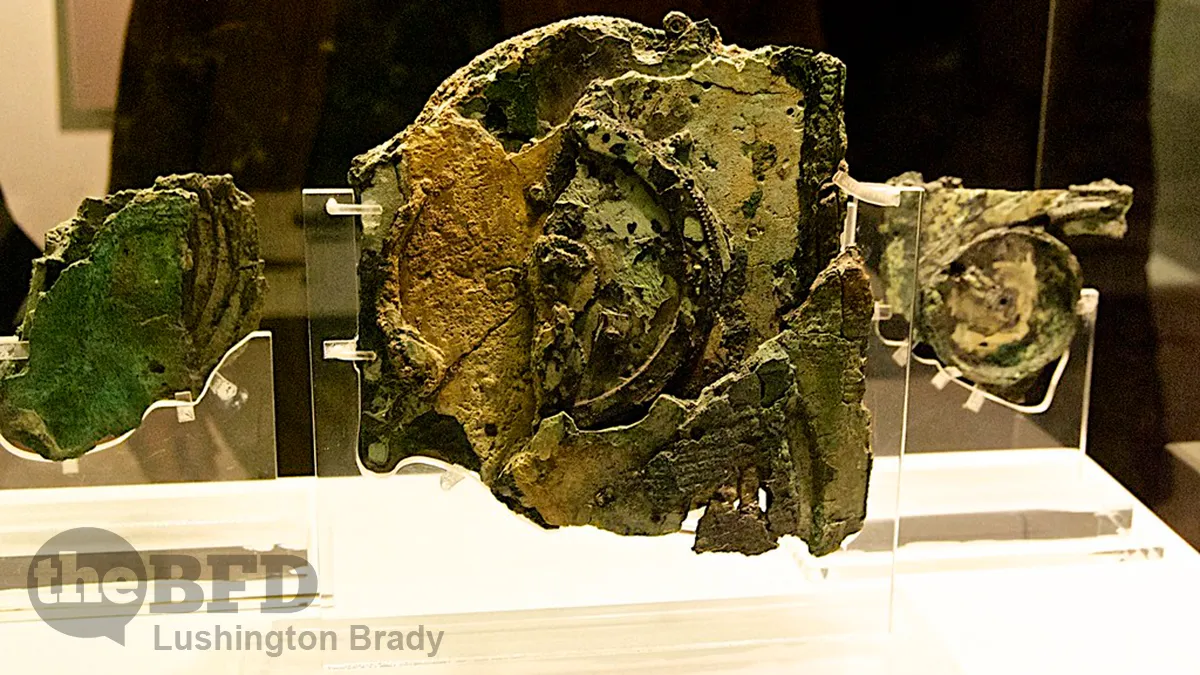In 1900, sponge divers found a submerged wreck off the Greek island of Antikythera. The wreck was a treasure trove, yielding bronze and marble statues, pottery, glassware, jewellery and coins. And a strange lump of corroded bronze and wood.
When the finds were sent to the National Museum of Archaeology in Athens, curators set to work on the obviously valuable stuff. The odd lumpy thing was mostly forgotten. Because it wasn’t immediately treated on retrieval from the sea, the object suffered deformational changes. It was also broken during retrieval. It wasn’t until nearly a year later that one archaeologist realised that a gear was embedded in the odd conglomeration.

The initial conclusion was that it was some sort of astronomical clock or calculator. It wasn’t until the 1970s that x-ray and gamma ray imagery revealed a mechanism of astonishing complexity, given that it was apparently constructed over 2000 years ago. Further dives in the 1970s found more pieces that are believed to have been part of the mechanism.
Gradually, it was realised that what is now known as the Antikythera mechanism is in fact an early analogue computer, used to keep track of celestial movements. It was apparently capable of predicting astronomical positions and eclipses decades in advance.
Now, cutting-edge technology is bringing to light even more details of this incredible ancient machine.
Researchers from the University of Glasgow in the UK have now used statistical modeling techniques borrowed from the study of gravitational waves to extrapolate missing details of a critical dial on [the] Antikythera mechanism.
Specifically, they determined that the part of the device known as the calendar ring would’ve had 354 holes punched into it (matching the lunar calendar). This is much more likely that other theories positing that there were 365 or 360 holes in it.
“Previous studies had suggested that the calendar ring was likely to have tracked the lunar calendar, but the dual techniques we’ve applied in this piece of work greatly increase the likelihood that this was the case,” says astrophysicist Joseph Bayley, from the University of Glasgow.
Of particular interest is the partially preserved front dial, or “calendar ring”. Closely spaced holes around the ring were used to align the dial. To know more about the dial’s function, scientists need to more accurately determine their exact arrangement.
In something of a cosmic irony, the latest research on this ancient astronomical computer has involved astrophysicists, using techniques more often employed at the cutting edge of astronomy: studying gravitational waves. The method involves, essentially, closely scrutinising the existing data to try and figure out what’s missing.
To deduce the missing details, researchers have now used Bayesian statistical methods to come up with the smartest possible guess about the number of holes punched into the calendar ring. The positioning and size of the existing rings was analyzed to figure out the probabilities of what was no longer evident […]
“It’s given me a new appreciation for the Antikythera mechanism and the work and care that Greek craftspeople put into making it,” says Bayley.
“The precision of the holes’ positioning would have required highly accurate measurement techniques and an incredibly steady hand to punch them” […]
The research found a radial variation of just 0.028 millimeters (0.001 inches) per hole, meaning it was fantastically precise given the tools of the time. It tells us a little more about one of the most intriguing historical artifacts ever found.
MSN

Curiously, Antikythera is not far from Crete, which was long supposed to be the home of the legendary craftsman Daedalus. The only problem is that Daedelus was supposed to have lived at least 1200 years before the Antikythera mechanism was constructed.








